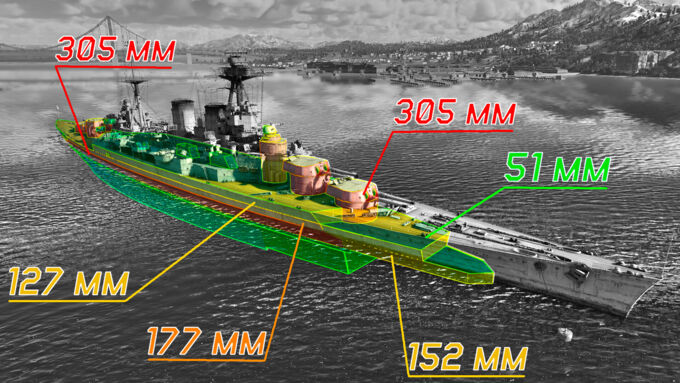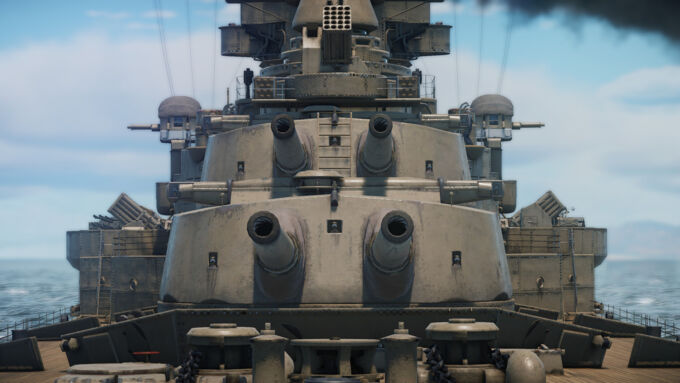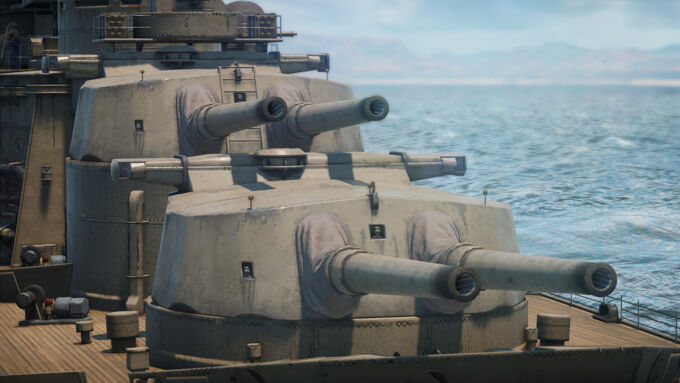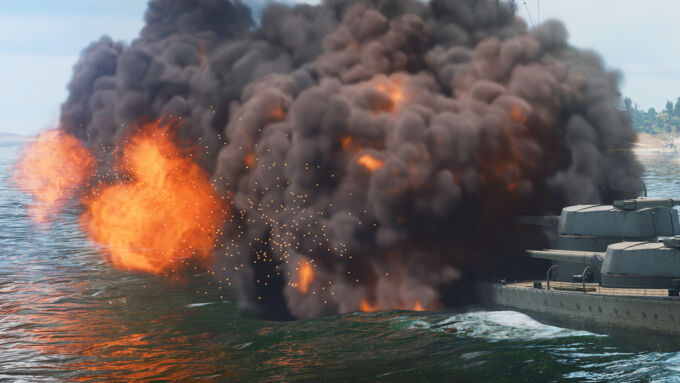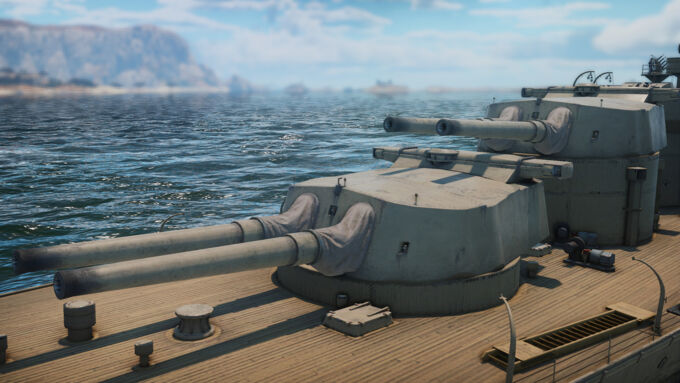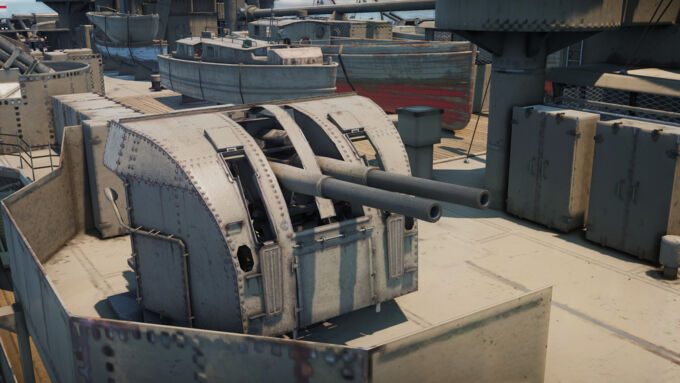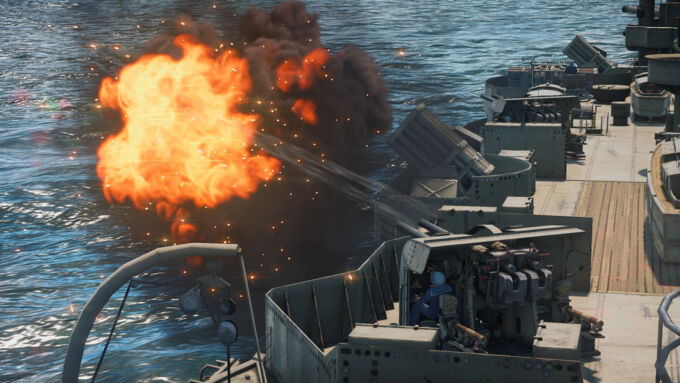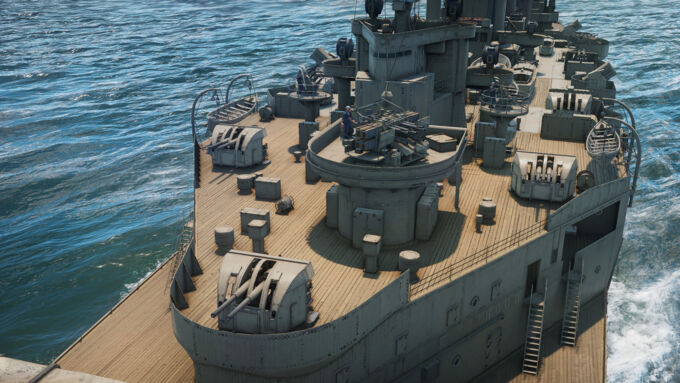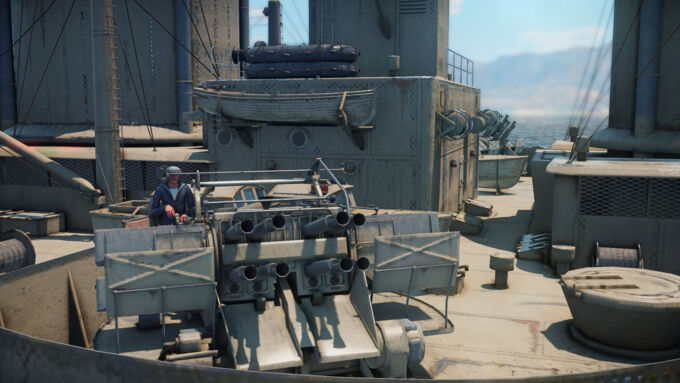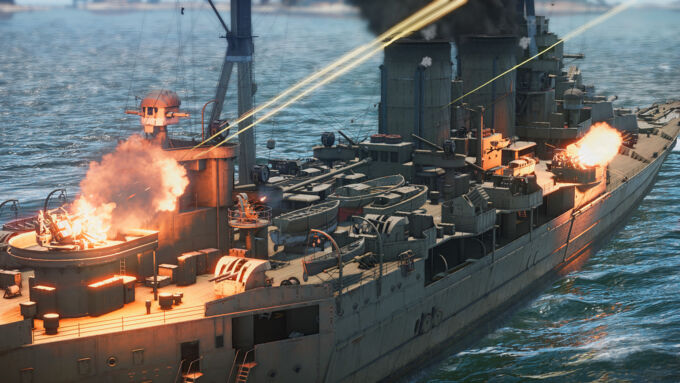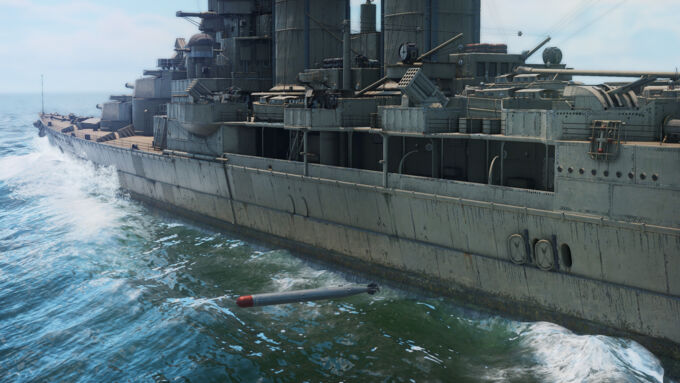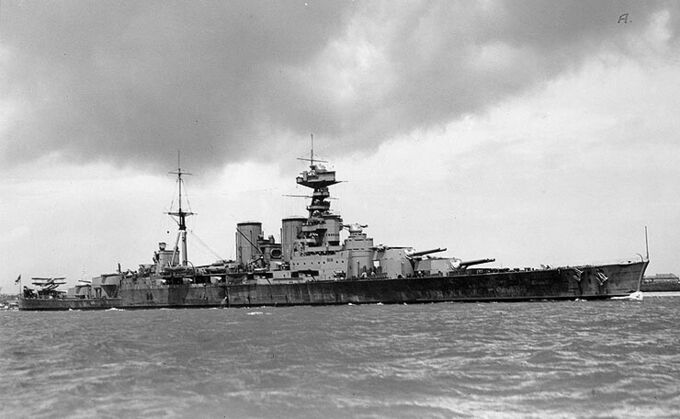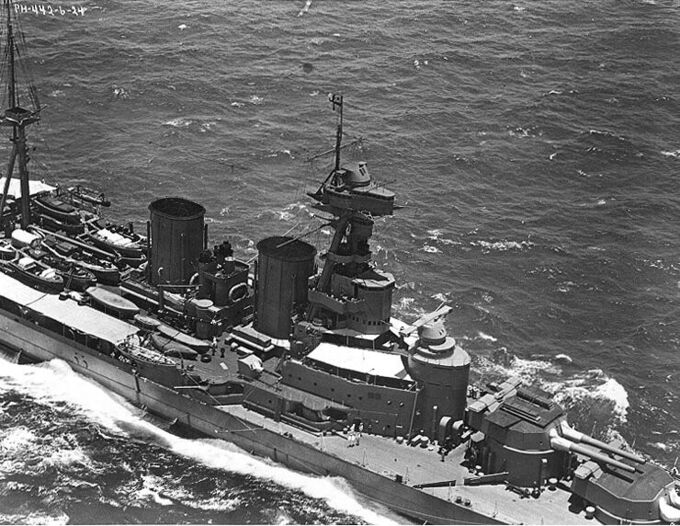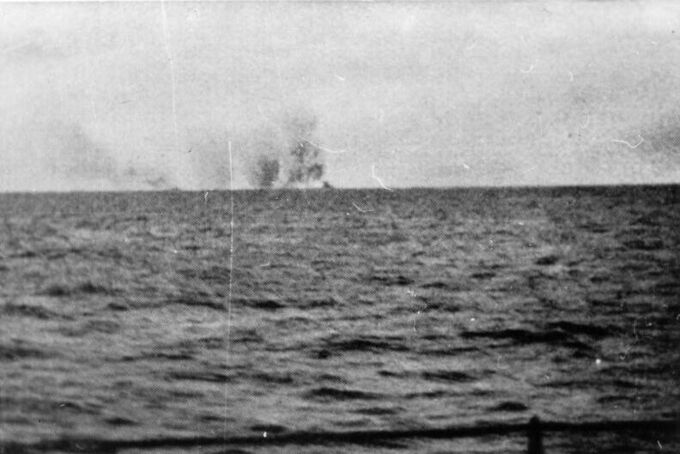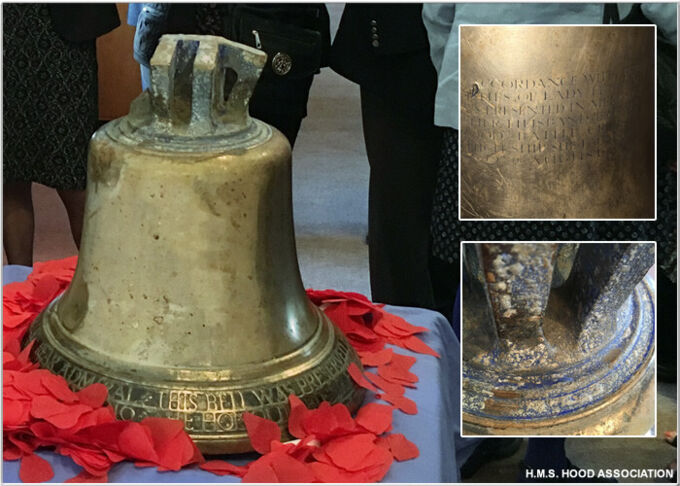HMS Hood is one of the most powerful buttlecruisers ever built. Originally designed as fast battleship it was reclassified by order of the First Sea Lord, Admiral John Jellicoe. The design was repeatedly modified based on combat experience, making the Hood the most powerful capital ship at the time she was comissioned in 1920. Being the top battlecruiser of the Royal Navy tech tree, HMS Hood, is characterized by a very powerful primary armament and a fairly numerous, though not particularly strong, secondary armament. It boasts good mobility but suffers from rather average armor by battleship standards, as well as a weak air defense battery. More details below.
Armor and survivability
Hood's armor protection is generally pretty good.
Vertical armor
Vertical hull armor is represented by a 304.8 mm thick main belt running along the waterline and thinning to 127 mm at the bow and 152 mm at the stern, a 177.8 mm thick middle belt, also thinning to 127 mm at the tips, and an upper belt of constant thickness of 127 mm. The underwater part of the hull is also covered by bulges, which are bounded by 38.1 mm thick armor bulkheads thinning to 12.7 mm at the amidships. In addition, two 19.05 mm thick torpedo bulkheads are installed inside the hull. Near the barbettes of turrets “A” and “Y” at mid-deck level there are armor transverses 101.6 mm thick. Closer to bow and stern between the middle and lower deck are 127 mm thick transverses, and between the lower deck and bilge - 38.1 mm thick.
The barbettes of turrets “A” and “Y” fore and aft have additional protection below the middle deck of 254 and 228.6 mm thick respectively. The opposite part of the barbettes are protected a little weaker, 127 mm in all turrets below the middle deck. However, the part of the barbette above the middle deck is protected by 304.8 mm thick plates. The bridge is protected by plates of different thickness - 254 mm fore and 279 mm aft. A 50.8 mm thick bevel runs from the middle deck to the lower part of the main belt. The main battery turrets are covered with plates of different thickness - the turret forehead is 381 mm, the sides are 254 mm. All external armor is made of surface hardened Krupp cemented armor (rolled cemented armor in the game), all internal armor is made of rolled homogeneous armor.
Horizontal armor
This is more modest, although it is one of the few ships to have four decks. The upper deck is 31.75 mm thick at the bow, 50.8 mm thick above the magazines near the turrets, 31.75 mm thick at the amidships and 19.05 thick aft. Middle - 50.8 mm in the vicinity of the magazines, 19.05 on the amidships, the extremities are not covered. Lower deck - 76.2 mm in the vicinity of the magazines, 50.8 mm at amidships. Bilge deck in the bow - 38.1 mm, to the magazines 50.8 mm, aft 25.4 mm. The roofs of the main battery turrets are covered with 127 mm armor plates. In general, quite decent for a ship of the times of the World War One.
The crew is 1,418. This is not a small number, but, however, it is not a lot. By comparison, the USS Nevada has a crew of 2,238, the IJN Fuso has 1,900, the Parizhskaya Communa has 1,730, but there is also, for example, the SMS Bayern with 1,276 crew, Izmail with 1,252 persons and HMS Warspite with 1,220. So Hood's crew number is pretty average. The only problem with the Hood's crew is that for the most part they are concentrated in the center of the ship. Among other things, the midship part is quite prone to fires — in this part are located auxiliary and anti-aircraft guns in semi-open shield mounts. Therefore, the crew of the Hood can dwindle quite quickly under the fire of rapid-firing cruisers, and it is worth taking into account in battle. Still Hood's survivability is very solid, as ship can take many hits both from cruisers and battleships without penetration of it's armor or doing not much damage to critical modules.
Mobility
The mobility of the ship is more than decent for its size, not without reason it is a battlecruiser — 30.7 knots (57 km/h) forward and 14 knots back (26 km/h) in realistic mode and 36.1 knots (67 km/h) forward and 16.2 knots back (30 km/h) in realistic mode, which is quite good. The most similar characteristics in terms of speed have vessels of Kongo-class or the infamous Scharnhorst.
However, HMS Hood has peculiarities that must be taken into account in combat — a large turning radius due to the length of the ship, and in addition the ship is quite slow to gain speed, but quickly stops, which is a consequence of its large displacement.
Armament
Main battery
The main battery of the battlecruiser is represented by eight 15” (381 mm)/42 Mark I guns, placed in pairs in four Mk. II mounts, which, in turn, are located linearly elevated in the bow and stern of the ship. Traditionally for the Royal Navy, the turrets were named by the letters of the alphabet from bow to stern - “A”, “B”, “X”, “Y”.
There are several types of shells available for the main battery:
- Semi-armor-piercing shell with armor-piercing tip and ballistic cap, 4crh - 752 m/s, 871 kg/58.6 kg TNT, armor penetration - 225 mm at a distance of 1000 m, 211 mm @ 2.5 km, 189 mm @ 5 km;
- Armor-Piercing Capped Ballistic Cap, 4crh, Mark XIIa - 752 m/s, 871 kg/22 kg Shellite (mixture of picric acid and dinitrophenol, TNT equivalent - 20.68 kg), armor penetration - 644 mm at a distance of 1000 m, 597 mm @ 2.5 km, 528 mm @ 5 km;
- Armor-Piercing Capped Ballistic Cap, Mark XVIIb - 749 m/s, 879 kg/22 kg Shellite, armor penetration - 655 mm at 1000 m, 619 mm @ 2.5 km, 565 mm @ 5 km.
Both SAP and APC shells are equally needed, as the SAP shell is effective against light and heavy cruisers, which the Hood encounters in abundance, while the APC shell is needed to counter battleships. The difference between the Mk. XIIa and Mk. XVIIb APC shells is small and the explosive charge is the same, but the top-of-the-line Mk. XVIIb still has greater armor penetration, which is maintained at longer range, so it is better to use it instead of Mk. XIIa.
The significant charge contained in the shells, as well as the great armor penetration ability of APC shells allow HMS Hood to easily deal with any enemy, whether it is a battleship of the World War One or World War Two, or a cruiser. However, these guns have an important disadvantage - their accuracy. It may be enough to fire at a distance of 10 km, but it will be difficult to shoot at enemies at 14-15 km, because the dispersion of shells is too unpredictable.
Secondary armament
The secondary armament is represented by seven paired Mark XIX mounts with 102 mm/45 Mark XVI dual-purpose guns, placed on the shelter deck closer to the mainmast. These guns will not compete with the secondaries of U.S. ships (for example 5 inch/38 Mk.12 cannon), but are quite good against small targets such as coastal fleet ships, and also provide formidable long-range air defense.
Available shells are as follows:
- High-explosive fragmentation shell — 811 m/s, 15.88 kg/1.55 kg of Amatol, armor penetration - 20 mm at all ranges.
- Semi-armor-piercing shell — 811 m/s, 17.35 kg/0.6 kg of Amatol, armor penetration - 102 mm at a distance of 1000 m, 85 mm @ 2.5 km, 64 mm @ 5 km.
- High-explosive with time fuze — has the same characteristics as the conventional HE.
High-explosive variable time fuze shell is not currently available. It is recommended to take two types of shells, and manually change between them depending on the target — SAP shells against destroyers or bigger targets, and HE-TF against aircraft and coastal fleet.
Anti-aircraft armament
The anti-aircraft armament is represented by three octuple mounts of 40 mm 2pdr QF Mk.VIII (“pom-pom”) automatic guns and four quadruple mounts of 12,7 mm Vickers Mk.V machine guns. AA battery is not great, not terrible. It is enough to repel an attack by a couple of strike aircraft or torpedo-bombers, but not more. The "pom-poms" have very mediocre ballistics, which allows them to be of use only at close to medium range, and the Vickers machine guns have very mediocre damage. It is better not to rely too much on these guns and stay close to allies with more powerful batteries in case of a massive air raid.
Torpedo armament
HMS Hood is equipped with four twin 533 mm torpedo tubes and have twelve 533 mm Mark IV torpedoes aboard. Mk. IV torpedo can travel 7.3 km at a speed of 65 km/h (35 knots) and have a warhead containing 234 kg of TNT. In general, the torpedoes are mediocre and it is quite difficult to use them, as the torpedo tubes are rigidly fixed in the hull. Besides, the stock of torpedoes is an extremely fire and explosion hazardous cargo, so it is better not to take them.
The ship does not have a scout plane.
Combat usage
HMS Hood is one of the best battlecruisers, both in reality and in the game. The destructive power of the Mark I guns is enough to destroy enemy ships with couple full salvos and it's mobility is great. But it is dangerous to come close to enemies — the midship part of the ship is very often and abundantly burns at the mass firing of medium caliber high-explosive shells, which makes the most dangerous of its opponents light cruisers with high-speed main caliber, such as American ships such as Cleveland, Fargo, Brooklyn, Italian light cruisers (for example RN Eugenio di Savoia) or Soviet ones of Project 68 (for example Mikhail Kutuzov) . Such opponents should be destroyed as quickly as possible, while keeping as much of a distance, as possible.
History
The story of the battlecruiser HMS Hood began before the Battle of Jutland. In 1915 the Admiralty placed an order for the development of new battleships, the design of which would be based on the battleships of the Queen Elizabeth-class. However, when the elaborate designs were received by the First Sea Lord, Admiral John Jellicoe, he told that there was no need for new battleships - Grand Fleet already had a serious superiority over the High Seas Fleet in ships of this class.
But there was an urgent need for battlecruisers — there were reports of seven new German battlecruisers being laid down. In this case, the Sea Lord rejected the projects of fast battleships — according to available information, the new German “Mackensen”-class had a 30 knot speed (the erroneous reporting by the British intelligence services), and fast battleships could not counter them. The development of new battlecruisers began. This is how the “Admiral”-class came into being.
HMS Hood was laid down in May 1916. However, after Battle of Jutland, construction was suspended — the loss of three battlecruisers was a severe blow to the old concepts. As a result, the armor was significantly strengthened, the thickness of the main armor belt increased to 305 mm - 1.5 times! All ships of the project were re-pledged, but after the end of the First World War, the construction of the remaining 3 ships (“Howe”, “Anson”, “Rodney”) was canceled in favor of the development of newer ships, only “Hood” was completed.
Commissioned in 1920, "Hood" became the most powerful and largest ship in the British Royal Navy. During the interwar period there was no ship more famous than the HMS Hood, both in Great Britain and abroad. In 1923-1924, the Special Purpose Squadron, led by "Hood", made a round-the-world expedition, visiting a huge number of ports during a 10 month tour.
Throughout the entire interwar period the battlecruiser participated in exercises and parades, demonstrating the power of the Royal Navy. In the 1930s the ship underwent several minor modernisations and repairs, but its condition was inevitably deteriorating. “Hood” required a complete overhaul and major modernization, which was scheduled for 1941. Unfortunately, however, the plans never came to fruition....
Source: US military - U.S. Naval Historical Center Photograph, Photo #: NH 60450
At the beginning of World War Two, the ship managed to participate in Operation Catapult, a series of small operations to capture and destroy ships of the French Navy after the surrender of France. In particular, the compound, led by “Hood”, attacked the port of Mers-el-Kébir as a main part of Operation. One battleship was destroyed and several warships were damaged. Subsequently, “Hood” operated for some time in northern waters, but did not achieve much success in combat, being more a symbol of the Royal Navy power.
On May 23, 1941 HMS Hood, together with the battleship HMS Prince of Wales and their escorting destroyers (later were sent north to search for the temporarily missing “Bismarck” and did not participate in the battle), went to the area of the Denmark Strait to intercept the German squadron consisting of the battleship “Bismarck” and heavy cruiser “Prince Eugen”, about the departure of which the British Intellegence knew in advance. The ships were also joined by the cruisers HMS Suffolk and HMS Norfolk, which had earlier detected the "Bismarck".
On May 24, without waiting for the approach of the ships of Admiral Tovey, the commander of the unit Admiral Holland decided to engage the Germans. In this case, the British capital ships - “Hood” and “Prince of Wales” - were at a disadvantage: Holland ordered a full course to approach the enemy, which led to the fact that only four main guns of “Hood” and six 356 mm guns of “Prince of Wales” could shoot at the “Bismarck” . At the same time, the accuracy of firing was unsatisfactory, firstly, because of the high speed of the ships, and secondly, because of the fact that the turret's rangefinders, which have a large base, and therefore more accurate than those used in the fire-control tower, were flooded with water. At a distance of 18,100 meters, while turning to port in order to put into action stern guns, the "Hood" was hit by a salvo from the "Bismarck". A narrow column of flame then shot upward above the ship, after which the ship was enveloped in a cloud of smoke. The ship broke in half and sank. Casualties amounted to 1415 people, only three survived.
In the course of wartime studies, various versions of the cause of the sinking were proposed. In later studies (including those using computer models), there has been a reassessment and some theories (e.g., torpedo explosion) have been found to be erroneous or completely improbable. In general, contrary to a very widespread opinion, it can be stated that the cause of the sinking was not due to a general weakness of the armor, but to a very unlucky hit on certain vulnerable areas or even an accidental failure.
On May 24, 2016 — the 75th anniversary of the Battle of Denmark Strait — a bell lifted from the battlecruiser was ceremonially installed at the National Museum of the Navy in Portsmouth. It can be seen in the exhibition dedicated to the Battle of Jutland.

